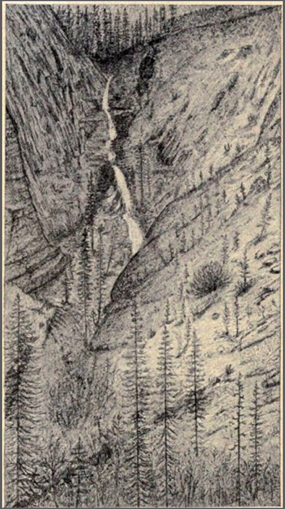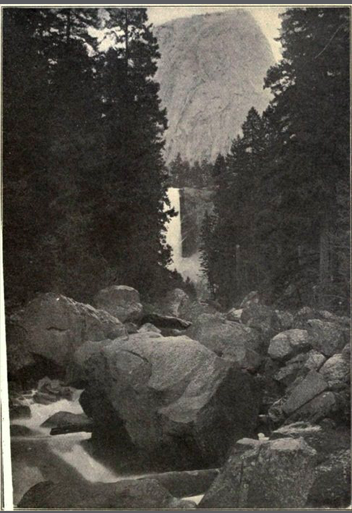From My First Summer in the Sierra
By John Muir
Annotations by Abby Army

photograph from My First Summer in the Sierra.
July 15. Followed the mono trail up the eastern rim of the basin nearly to its summit, then turned off southward to a small shallow valley that extends to the edge of the Yosemite, which we reached about noon, and encamped. After luncheon, I made haste to high ground, and from the top of the ridge on the west side of Indian Cañon gained the noblest view of the summit peaks I have ever yet enjoyed. Nearly all the upper basin of the Merced was displayed, with its sublime domes and canons, dark upsweeping forests, and [a] glorious array of white peaks deep in the sky, every feature glowing, radiating beauty that pours into our flesh and bones like heat rays from fire. Sunshine overall; no breath of wind to stir the brooding calm. Never before had I seen so glorious a landscape, so boundless an affluence of sublime mountain beauty. The most extravagant description I might give of this view to anyone who has not seen similar landscapes with his own eyes would not so much as hint at its grandeur and the spiritual glow that covered it. I shouted and gesticulated in a wild burst of ecstasy much to the astonishment of St. Bernard Carlo, who came running up to me, manifesting in his intelligent eyes a puzzled concern that was very ludicrous, which had the effect of bringing me to my senses. A brown bear, too, it would seem, had been a spectator of the show I had made of myself, for I had gone but a few yards when I started one from a thicket of brush. He evidently considered me dangerous, for he ran away very fast, tumbling over the tops of the tangled manzanita bushes in his haste. Carlo drew back, with his ears depressed as if afraid, and kept looking me in the face, as if expecting me to pursue and shoot, for he had seen many a bear battle in his day.
Following the ridge, which made a gradual descent to the south, I came at length to the brow of that massive cliff that stands between Indian Cañon and Yosemite Falls, and here the far-famed valley came suddenly into view throughout almost its whole extent. The noble walls—sculptured into an endless variety of domes and gables, spires and battlements and plain mural precipices—all a-tremble with the thunder tones of the falling water. The level bottom seemed to be dressed like a garden—sunny meadows here and there, and groves of pine and oak; the river of Mercy sweeping in majesty through the midst of them and flashing back the sunbeams. The great Tissiack, or Half-Dome, rising at the upper end of the valley to a height of nearly a mile, is nobly proportioned and life-like, the most impressive of all the rocks, holding the eye in devout admiration, calling it back again and again from falls or meadows, or even the mountains “beyond,—marvelous cliffs, marvelous in sheer dizzy depth and sculpture, types of endurance. Thousands of years have they stood in the sky exposed to rain, snow, frost, earthquake, and avalanche, yet they still wear the bloom of youth.
I rambled along the valley rim to the westward; most of it is rounded off on the very brink so that it is not easy to find places where one may look clear down the face of the wall to the bottom. When such places were found, and I had cautiously set my feet and drawn my body erect, I could not help fearing a little that the rock might split off and let me down, and what a down!—more than three thousand feet. Still, my limbs did not tremble, nor did I feel the least uncertainty as to the reliance to be placed on them. My only fear was that a flake of the granite, which in some places showed joints more or less open and running parallel with the face of the cliff, might give way. After withdrawing from such places, excited with the view I had got, I would say to myself, “Now don’t go out on the verge again.” But in the face of Yosemite scenery cautious remonstrance is vain; under its spell one’s body seems to go where it likes with a will over which we seem to have scarce any control.
After a mile or so of this memorable cliff work I approached Yosemite Creek, admiring its easy, graceful, confident gestures as it comes bravely forward in its narrow channel, singing the last of its mountain songs on its way to its fate—a few rods more over the shining granite, then down half a mile in showy foam to another world, to be lost in the Merced, where climate, vegetation, inhabitants, all are different. Emerging from its last gorge, it glides in wide lace-like rapids down a smooth incline into a pool where it seems to rest and compose its gray, agitated waters before taking the grand plunge, then slowly slipping over the lip of the pool basin, it descends another glossy slope with rapidly accelerated speed to the brink of the tremendous cliff, and with sublime, fateful confidence springs out free in the air.

from My First Summer in the Sierra, p. 150.
I took off my shoes and stockings and worked my way cautiously down alongside the rushing flood, keeping my feet and hands pressed firmly on the polished rock. The blooming, roaring water, rushing past close to my head was very exciting. I had expected that the sloping apron would terminate with the perpendicular wall of the valley, and that from the foot of it, where it is less steeply inclined, I should be able to lean far enough out to see the forms and behavior of the fall all the way down to the bottom. But I found that there was yet another small brow over which I could not see, and which appeared to be too steep for mortal feet. Scanning it keenly, I discovered a narrow shelf about three inches wide on the very brink, just wide enough for a rest for one’s heels. But there seemed to be no way of reaching it over so steep a brow. At length, after careful scrutiny of the surface, I found “an irregular edge of a flake of the rock some distance back from the margin of the torrent. If I was to get down to the brink at all that rough edge, which might offer slight finger-holds, was the only way. But the slope beside it looked dangerously smooth and steep, and the swift roaring flood beneath, overhead, and beside me was very nerve-trying. I, therefore, concluded not to venture farther but did nevertheless. Tufts of artemisia were growing in clefts of the rock nearby, and I filled my mouth with the bitter leaves, hoping they might help to prevent giddiness. Then, with a caution not known in ordinary circumstances, I crept down safely to the little ledge, got my heels well planted on it, then shuffled in a horizontal direction twenty or thirty feet until close to the outplunging current, which, by the time it had descended thus far, was already white. Here I obtained a perfectly free view down into the heart of the snowy, chanting throng of comet-like streamers, into which the body of the fall soon separates. “While perched on that narrow niche I was not distinctly conscious of danger. The tremendous grandeur of the fall in form and sound and motion, acting at close range, smothered the sense of fear, and in such places one’s body takes keen care for safety on its own account. How long I remained “down there, or how I returned, I can hardly tell. Anyhow I had a glorious time, and got back to camp about dark, enjoying triumphant exhilaration soon followed by dull weariness. Hereafter I’ll try to keep from such extravagant, nerve-straining places. Yet such a day is well worth venturing for. My first view of the High Sierra, first view looking down into Yosemite, the death song of Yosemite Creek, and its flight over the vast cliff, each one of these is of itself enough for a great life-long landscape fortune—a most memorable of days—enjoyment enough to kill if that were possible.
July 16. My enjoyments yesterday afternoon, especially at the head of the fall, were too great for good sleep. Kept starting up last night in a nervous tremor, half awake, fancying that the foundation of the mountain we were camped on had given way and was falling into Yosemite Valley. In vain I roused myself to make a new beginning for sound sleep. The nerve strain had been too great, and again and again I dreamed I was rushing through the air above a glorious avalanche of water and rock. One time, springing to my feet, I said, “This time it is real—all must die, and where could mountaineer find a more glorious death!”
Left camp soon after sunrise for an all day ramble eastward. Crossed the head of Indian Basin, forested with Abies magnifica, underbrush mostly Ceanothus cordulatus and manzanita, a mixture not easily trampled over or penetrated, for the ceanothus is thorny and grows in dense snow-pressed masses, and the manzanita has exceedingly crooked, stubborn branches. From the head of the cañon continued on past North Dome into the basin of Dome or Porcupine Creek. Here are many fine meadows imbedded in the woods, gay with Lilium parvum and its companions; the elevation, about eight thousand feet, seems to be best suited for it–saw specimens that were a foot or two higher than my head. Had more magnificent views of the upper mountains, and of the great South Dome, said to be the grandest rock in the world. Well it may be, since it is of such noble dimensions and sculpture. A wonderfully impressive monument, its lines exquisite in fineness, and though sublime in size, is finished like the finest work of art, and seems to be alive.

printed in My First Summer in the Sierra, p. 181.
Muir, John. From “Chapter 5: The Yosemite” In My First Summer in the Sierra, 115-122. Boston: Houghton MIfflin, 1917.
Contexts
My First Summer in the Sierra was first published in 1911; this text is from another printing in 1917 published as the “Sierra Edition.” The full text and illustrations from this edition are available at Project Gutenberg.
Resources for Further Study
- The Sierra Club has an extensive page dedicated to John Muir.